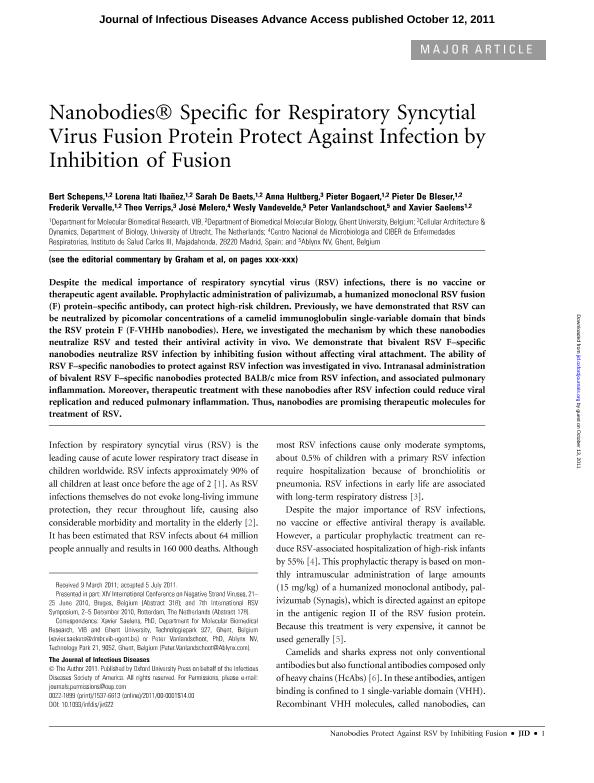Artículo
Nanobodies® specific for respiratory syncytial virus fusion protein protect against infection by inhibition of fusion
Schepens, Bert; Ibañez, Lorena Itatí ; De Baets, Sarah; Hultberg, Anna; Bogaert, Pieter; De Bleser, Pieter; Vervalle, Frederik; Verrips, Theo; Melero, José; Vandevelde, Wesly; Vanlandschoot, Peter; Saelens, Xavier
; De Baets, Sarah; Hultberg, Anna; Bogaert, Pieter; De Bleser, Pieter; Vervalle, Frederik; Verrips, Theo; Melero, José; Vandevelde, Wesly; Vanlandschoot, Peter; Saelens, Xavier
 ; De Baets, Sarah; Hultberg, Anna; Bogaert, Pieter; De Bleser, Pieter; Vervalle, Frederik; Verrips, Theo; Melero, José; Vandevelde, Wesly; Vanlandschoot, Peter; Saelens, Xavier
; De Baets, Sarah; Hultberg, Anna; Bogaert, Pieter; De Bleser, Pieter; Vervalle, Frederik; Verrips, Theo; Melero, José; Vandevelde, Wesly; Vanlandschoot, Peter; Saelens, Xavier
Fecha de publicación:
12/2011
Editorial:
University of Chicago Press
Revista:
Journal Of Infectious Diseases
ISSN:
0022-1899
Idioma:
Inglés
Tipo de recurso:
Artículo publicado
Clasificación temática:
Resumen
Despite the medical importance of respiratory syncytial virus (RSV) infections, there is no vaccine or therapeutic agent available. Prophylactic administration of palivizumab, a humanized monoclonal RSV fusion (F) protein-specific antibody, can protect high-risk children. Previously, we have demonstrated that RSV can be neutralized by picomolar concentrations of a camelid immunoglobulin single-variable domain that binds the RSV protein F (F-VHHb nanobodies). Here, we investigated the mechanism by which these nanobodies neutralize RSV and tested their antiviral activity in vivo. We demonstrate that bivalent RSV F-specific nanobodies neutralize RSV infection by inhibiting fusion without affecting viral attachment. The ability of RSV F-specific nanobodies to protect against RSV infection was investigated in vivo. Intranasal administration of bivalent RSV F-specific nanobodies protected BALB/c mice from RSV infection, and associated pulmonary inflammation. Moreover, therapeutic treatment with these nanobodies after RSV infection could reduce viral replication and reduced pulmonary inflammation. Thus, nanobodies are promising therapeutic molecules for treatment of RSV.
Palabras clave:
NANOBODY
,
ANTIVIRAL
,
RSV
,
CAMELID
Archivos asociados
Licencia
Identificadores
Colecciones
Articulos(SEDE CENTRAL)
Articulos de SEDE CENTRAL
Articulos de SEDE CENTRAL
Citación
Schepens, Bert; Ibañez, Lorena Itatí; De Baets, Sarah; Hultberg, Anna; Bogaert, Pieter; et al.; Nanobodies® specific for respiratory syncytial virus fusion protein protect against infection by inhibition of fusion; University of Chicago Press; Journal Of Infectious Diseases; 204; 11; 12-2011; 1692-1701
Compartir
Altmétricas



